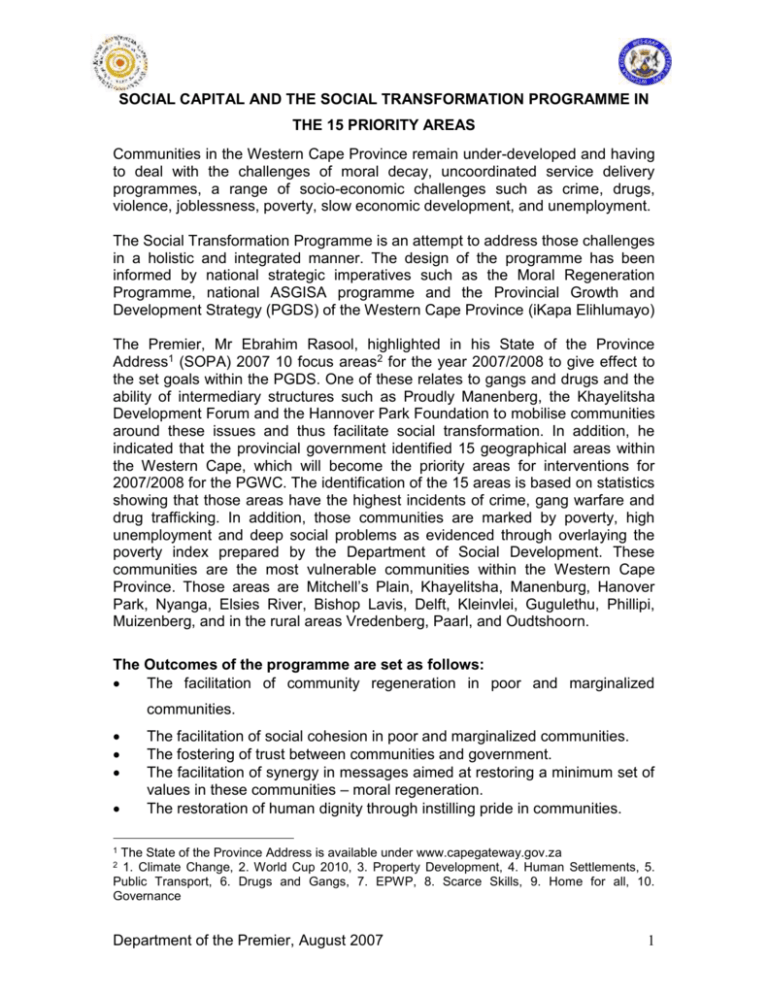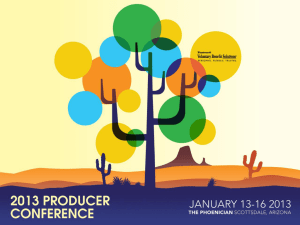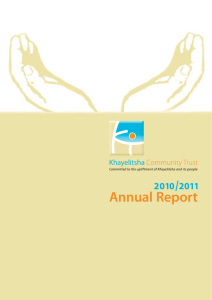proposal for the roll-out of the proudly manenberg campaign to an
advertisement

SOCIAL CAPITAL AND THE SOCIAL TRANSFORMATION PROGRAMME IN THE 15 PRIORITY AREAS Communities in the Western Cape Province remain under-developed and having to deal with the challenges of moral decay, uncoordinated service delivery programmes, a range of socio-economic challenges such as crime, drugs, violence, joblessness, poverty, slow economic development, and unemployment. The Social Transformation Programme is an attempt to address those challenges in a holistic and integrated manner. The design of the programme has been informed by national strategic imperatives such as the Moral Regeneration Programme, national ASGISA programme and the Provincial Growth and Development Strategy (PGDS) of the Western Cape Province (iKapa Elihlumayo) The Premier, Mr Ebrahim Rasool, highlighted in his State of the Province Address1 (SOPA) 2007 10 focus areas2 for the year 2007/2008 to give effect to the set goals within the PGDS. One of these relates to gangs and drugs and the ability of intermediary structures such as Proudly Manenberg, the Khayelitsha Development Forum and the Hannover Park Foundation to mobilise communities around these issues and thus facilitate social transformation. In addition, he indicated that the provincial government identified 15 geographical areas within the Western Cape, which will become the priority areas for interventions for 2007/2008 for the PGWC. The identification of the 15 areas is based on statistics showing that those areas have the highest incidents of crime, gang warfare and drug trafficking. In addition, those communities are marked by poverty, high unemployment and deep social problems as evidenced through overlaying the poverty index prepared by the Department of Social Development. These communities are the most vulnerable communities within the Western Cape Province. Those areas are Mitchell’s Plain, Khayelitsha, Manenburg, Hanover Park, Nyanga, Elsies River, Bishop Lavis, Delft, Kleinvlei, Gugulethu, Phillipi, Muizenberg, and in the rural areas Vredenberg, Paarl, and Oudtshoorn. The Outcomes of the programme are set as follows: The facilitation of community regeneration in poor and marginalized communities. The facilitation of social cohesion in poor and marginalized communities. The fostering of trust between communities and government. The facilitation of synergy in messages aimed at restoring a minimum set of values in these communities – moral regeneration. The restoration of human dignity through instilling pride in communities. 1 The State of the Province Address is available under www.capegateway.gov.za 1. Climate Change, 2. World Cup 2010, 3. Property Development, 4. Human Settlements, 5. Public Transport, 6. Drugs and Gangs, 7. EPWP, 8. Scarce Skills, 9. Home for all, 10. Governance 2 Department of the Premier, August 2007 1 The Programme Objectives are: To facilitate the establishment of 15 intermediary organizations in the communities of Mitchell’s Plain, Khayelitsha, Hanover Park, Nyanga, Elsies River, Bishop Lavis, Delft, Kleinvlei, Gugulethu, Phillipi, Muizenberg, Vredenburg, Paarl, and Oudtshoorn by 31 March 2007. To ensure a needs-based and integrated delivery of public sector services in the prioritized 15 areas. To facilitate an integrated response from the business sector in the prioritized 15 areas. To document the programme roll-out in the 15 areas. To build internal social capital within the PGWC in order to facilitate integrated service delivery through the roll-out of the social transformation programme. To institutionalize structures and processes within PGWC in order to facilitate the implementation of the social transformation programme. Looking at the outcomes the clear link between social capital appears. Words such as trust, and values strongly remind of social capital. The objectives reflect that the approach and working method of the programme takes place through a social capital lens. The strong emphasis on networking and collaboration are closely linked to social capital. Following certain elements between social capital and the Social Transformation Programme will be highlighted: Linking and bridging of Social capital plays a strong role in the Social Transformation programme because it addresses the need of partnerships and networks on a horizontal and vertical level. One of the most important roles for government within the programme is to link communities to its own networks in society. The programme will promote targeted and focused partnerships among business, government, communities and civil society. Building of trust will be one of the key elements of relationship and partnership building. In addition, linking and bridging will also take place within government. The different spheres and structures in government have to change their way of cooperating and strengthen their partnerships. Coordination and collaboration across spheres, departments and units will be a new work approach. Trust: One of the goals of the Social Transformation Programme is to build trust between government and communities. In the past, a lack of coordination and failures in service delivery have harmed the trust between government and communities. Collaboration and partnership on a long-term basis will help to restore trust and establish trust. Values and moral regeneration: Through the Social Transformation Programme it will be possible for the communities to regenerate their own community values and establish new values. Collaboration between the Department of the Premier, August 2007 2 various sectors within communities but also among other societal actors will create an environment of trust and respect. Collaboration and networking is not always easy and entails a lot of challenges but in the end it might embrace diversity. Networks that enable collective action: The envisaged establishment of intermediary structures is a network that enables communities to act collectively, participate constructively, facilitate access to services and Participation in an intermediary network provides poor communities access to information, resources and decision-making vested in government without the additional burden of having to negotiate the bureaucratic maze. In summary, particularly the intermediary structure is a tool to facilitate social transformation through social capital with a community development approach. It provides communities with access to the resources and opportunities of government, as well as the networks of government, the ngo sector, the religious sector and the business sector to unlock further opportunities for communities. Executive Summary Social Transformation Programme and Progress to date Post Cabinet Progress Report for the Identified 15 Areas Department of the Premier, August 2007 3









